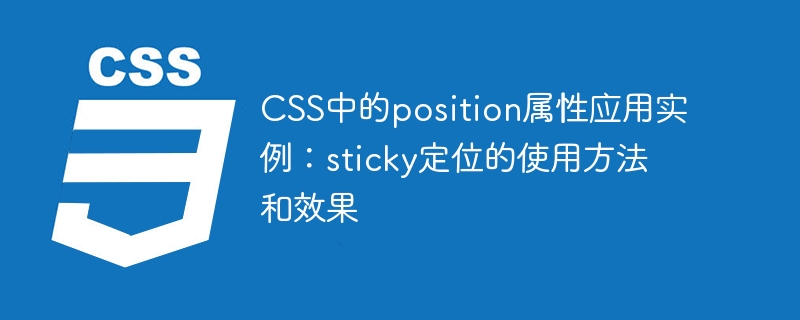

Application examples of the position attribute in CSS: usage and effects of sticky positioning
In front-end development, we often use the position attribute of CSS to control the positioning of elements. . Among them, the position attribute has four optional values: static, relative, absolute and fixed. In addition to these common location attributes, there is also a special positioning method, namely sticky positioning. This article will explore the use and effects of sticky positioning and provide specific code examples.
1. Introduction to sticky positioning
sticky positioning is a new positioning method in CSS3. It is mainly used to achieve that when the page scrolls to a certain position, the element will be fixed at the specified position. Effect. This positioning method combines the characteristics of fixed and relative positioning, showing a "sticky" effect.
2. Basic styles and effects of sticky positioning
When using sticky positioning, we need to set the position of the element to sticky and specify the corresponding top, right, bottom or left value. The commonly used settings are as follows:
.sticky-element { position: sticky; top: 0; }
In the above example, we set the position of an element to sticky and place it at the top of the page (top: 0). This way, when the page scrolls, the element will remain at the top of the page until it scrolls to the specified position.
3. Compatibility and precautions of sticky positioning
It should be noted that the compatibility of sticky positioning in different browsers may vary. Currently, most mainstream browsers already support sticky positioning, including Chrome, Firefox, Safari, Edge, etc. However, in some lower version browsers, it may not be supported or there may be some bugs. Therefore, when using sticky positioning, you need to test the compatibility of different browsers and make corresponding compatibility processing according to the actual situation.
In addition, it should be noted that when using sticky positioning, ensure that the element has enough space for positioning within its parent element. If the parent element is not tall enough to contain the sticky element, the positioning effect of the sticky element may fail when scrolling.
4. Application examples of sticky positioning
The following uses specific examples to demonstrate the application of sticky positioning.
In the above example, we created a container with a height of 300px and set overflow-y: scroll to simulate the scrolling effect of the page. Inside the container, we add a sticky-element element and set its position to sticky and top to 0. When we run the example in the browser, we can see that the sticky-element element remains fixed at the top of the container when scrolled.
5. Summary
This article introduces the usage and effect of sticky positioning, a special value of the position attribute in CSS, and provides specific code examples. By using sticky positioning, we can easily achieve the "sticky" effect of elements when the page is scrolled, adding some dynamics and appeal to the page. However, when using sticky positioning, you need to pay attention to compatibility and space issues of the parent element. I hope this article can provide some help for everyone in applying sticky positioning in front-end development.
The above is the detailed content of Usage and effect display of sticky positioning attribute in CSS. For more information, please follow other related articles on the PHP Chinese website!